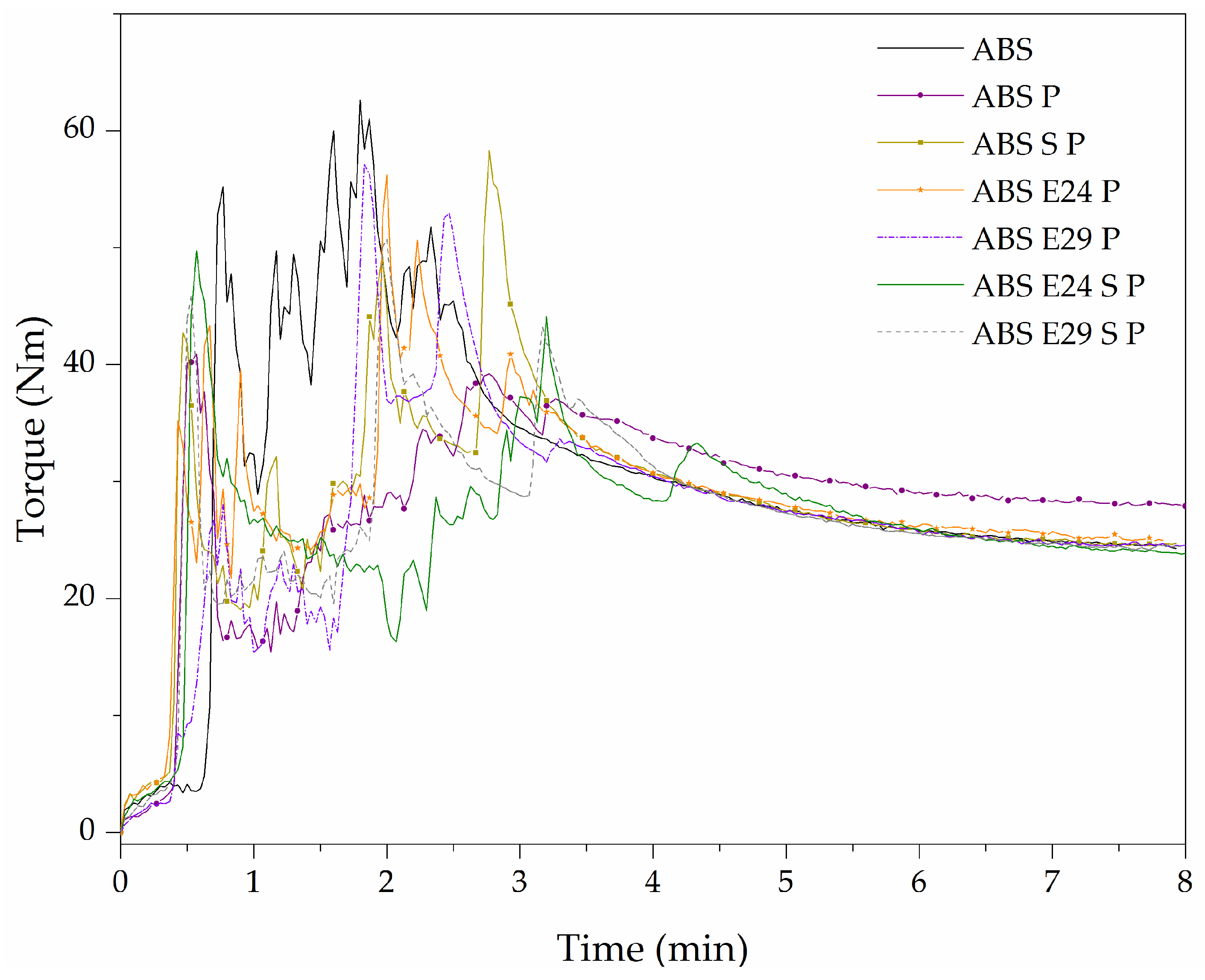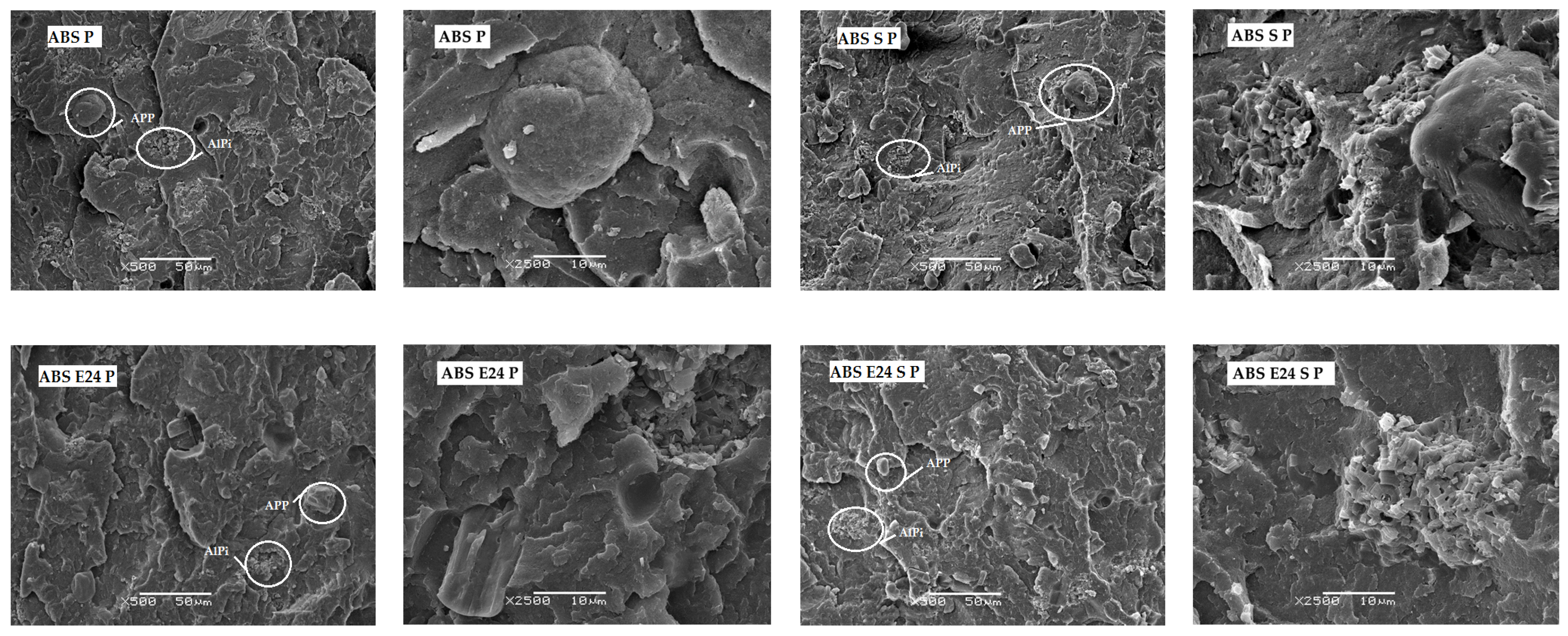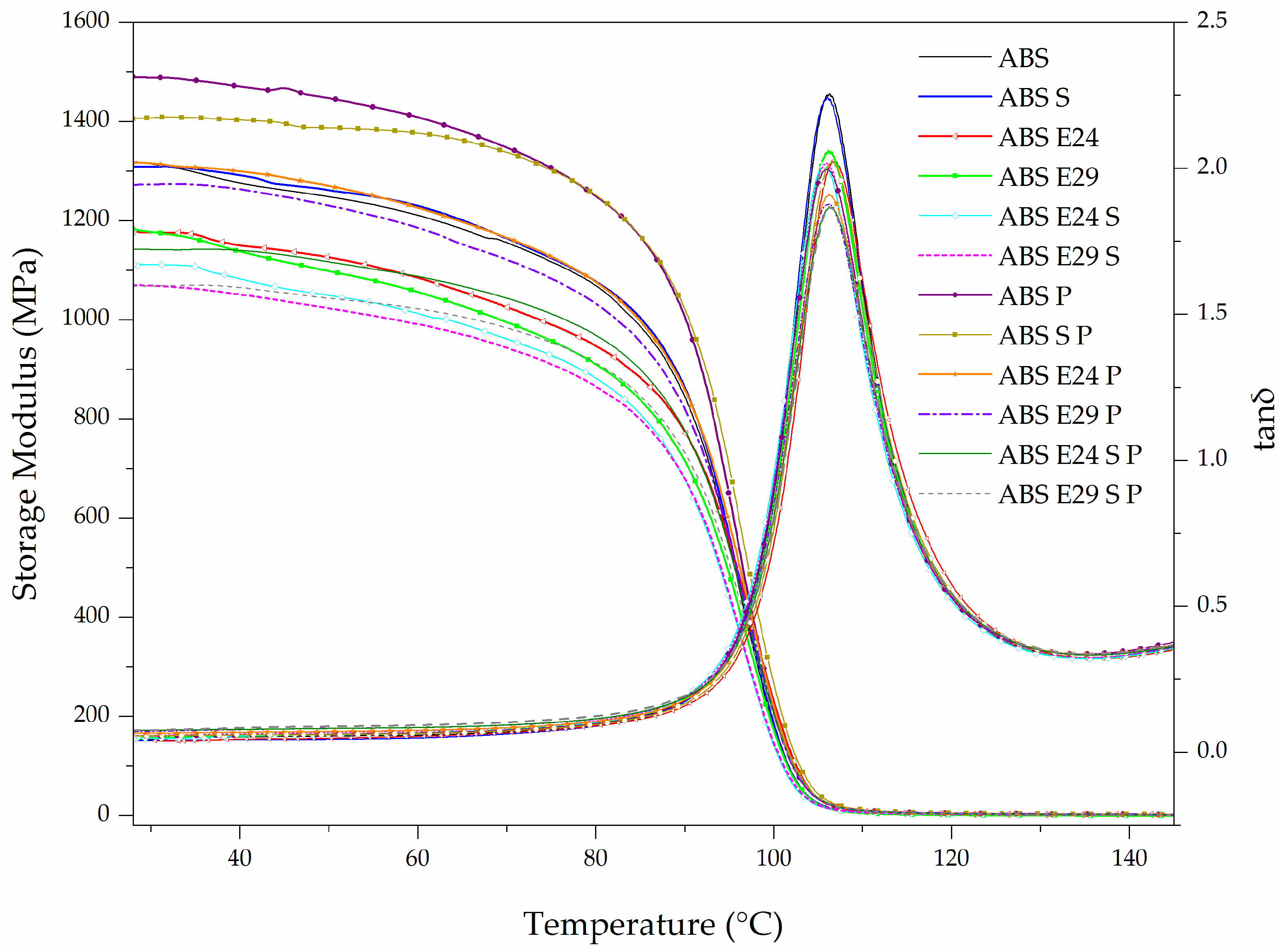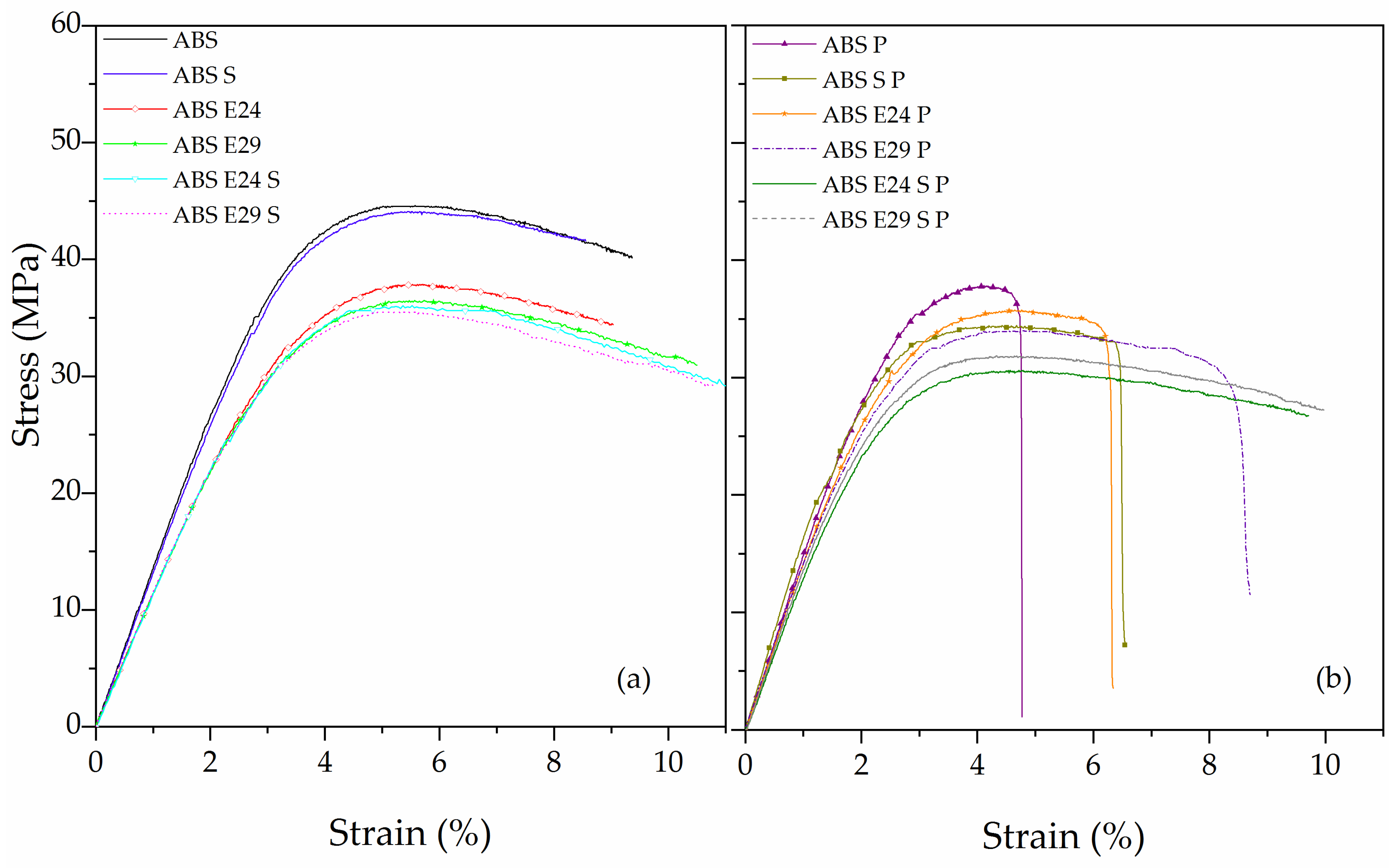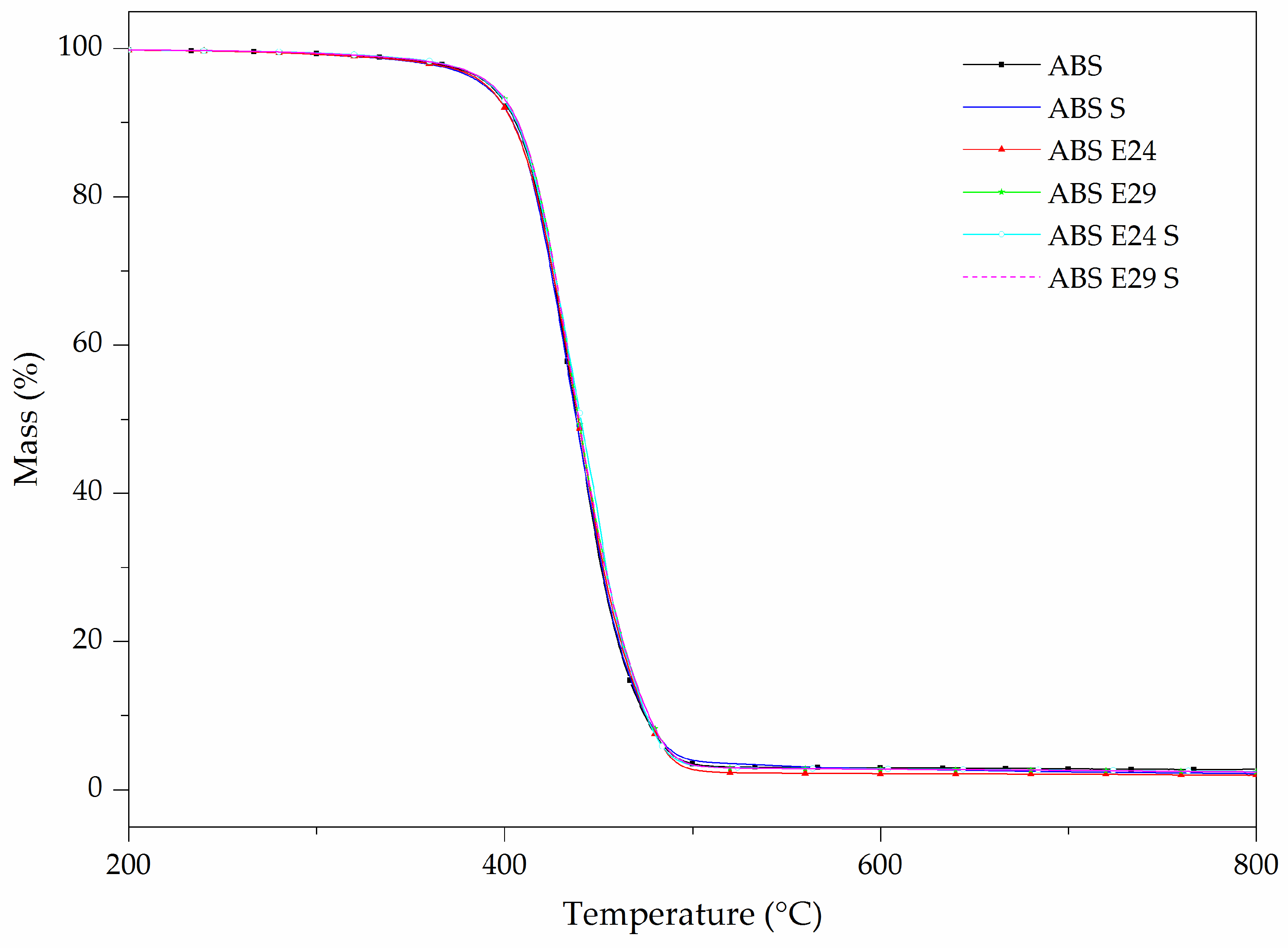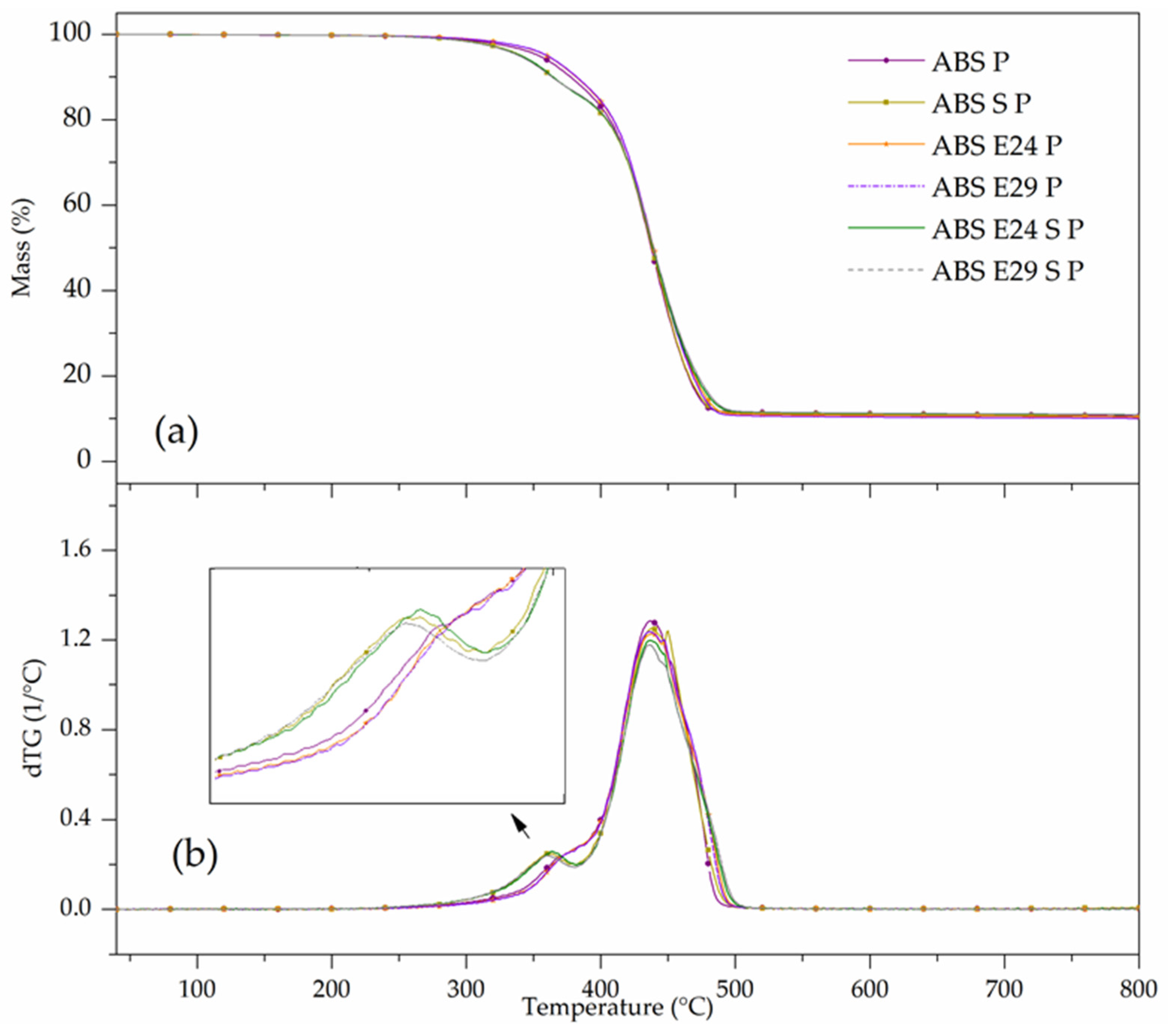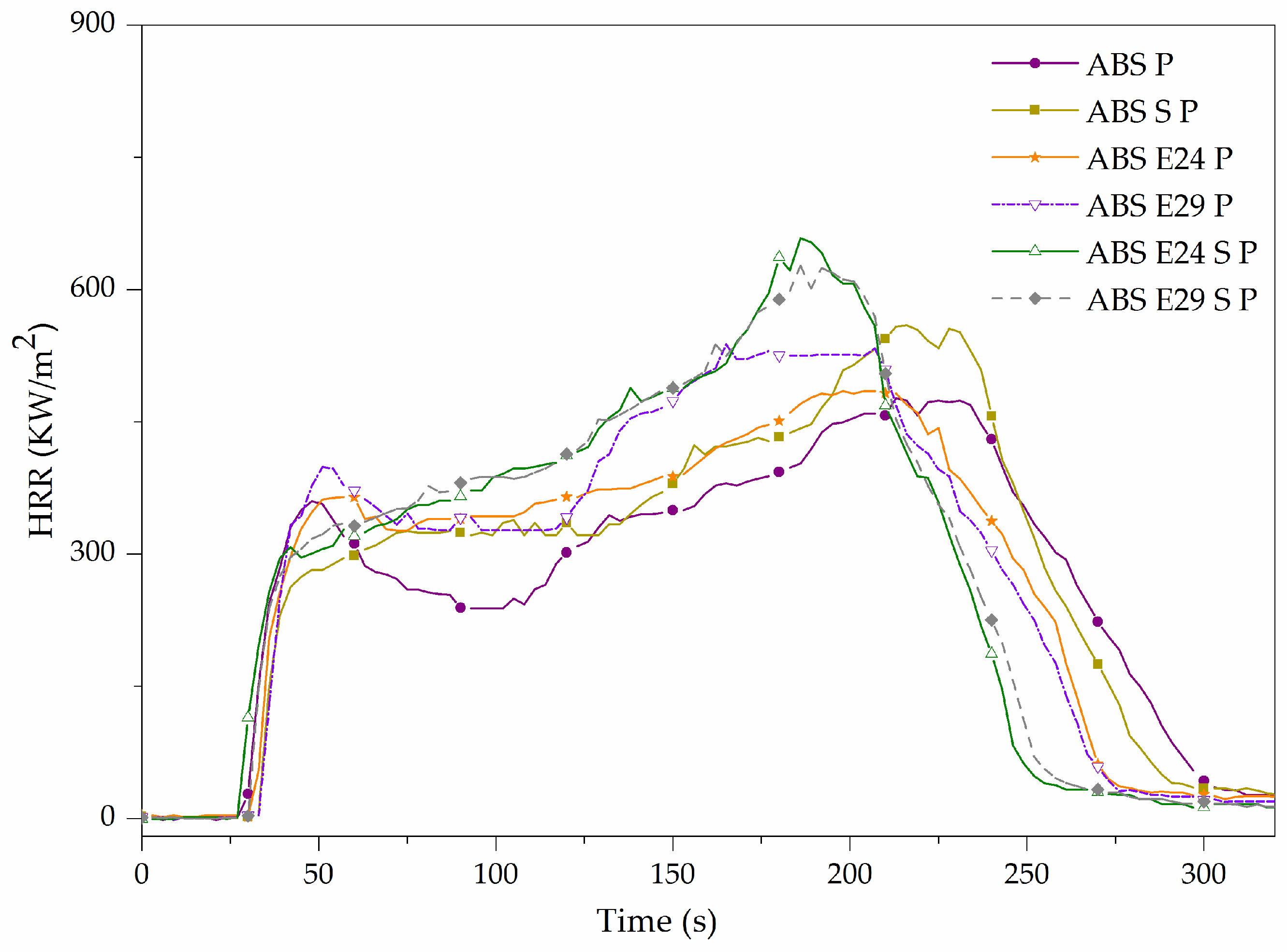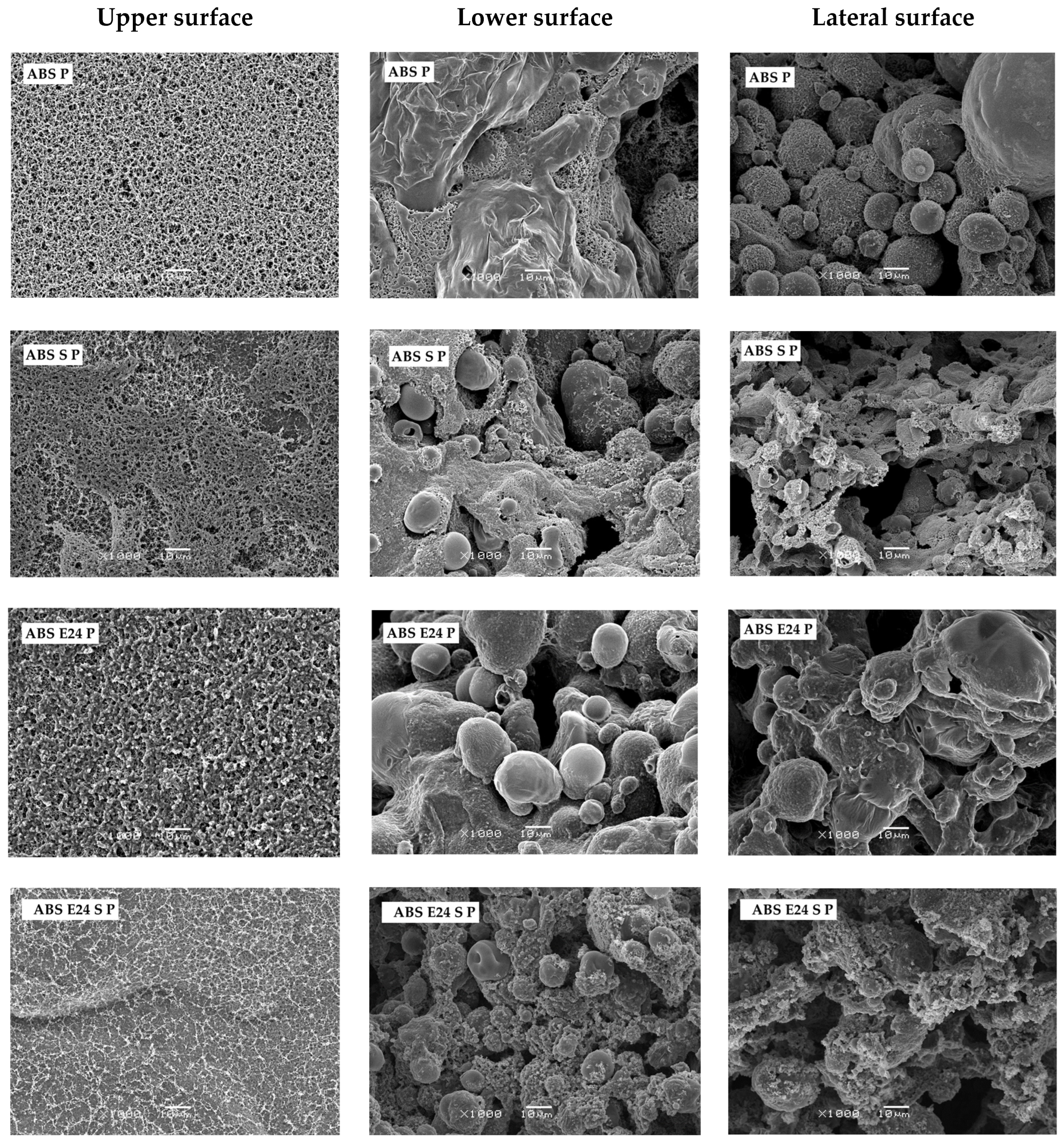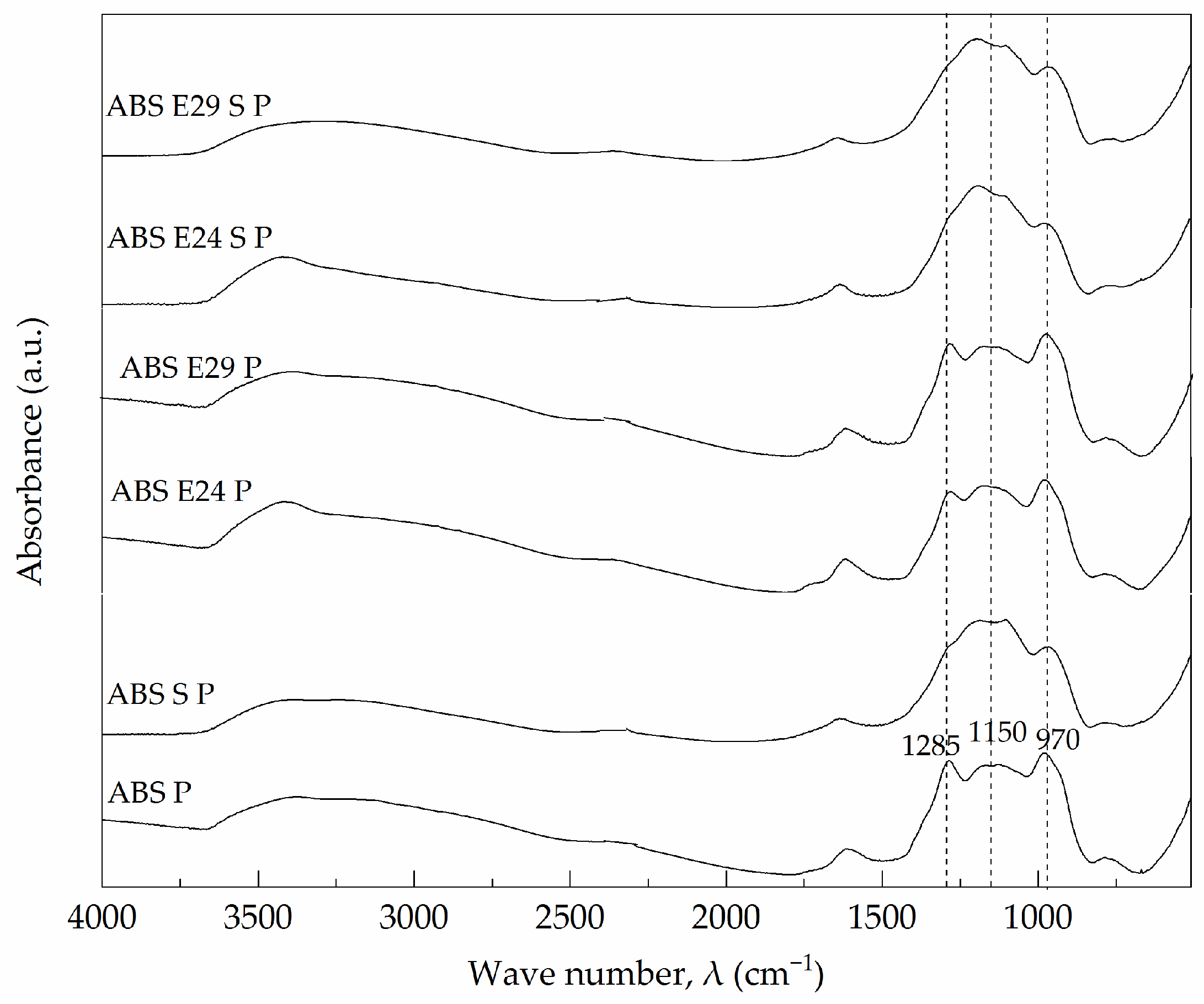1. Introduction
Acrylonitrile butadiene styrene (ABS), an engineering thermoplastic, consisting of polybutadiene as a discrete phase and styrene–acrylonitrile copolymer as a continuous phase has been widely used in many industrial applications due to its toughness, impact resistance, chemical resistance and easy processing [
1,
2,
3]. However, the high flammability of ABS combined with its smoke production limits its applications. In order to find a solution for its inherent high flammability and suppress the production of dark smoke, the use of different flame-retardant additives (FRs) in ABS has been studied [
4,
5,
6]. Most of the drawbacks related to flame retardancy of ABS were considered overcome by introducing brominated FRs into the market [
5]. However, in the 1990s, it was reported that some of these FRs, like poly brominated diphenyl ethers (PBDEs), release toxic gasses and adversely affect the environment and human health [
7]. Therefore, halogen-free flame retardants (HFFRs), based on phosphorus-containing compounds with different oxidation states were developed and introduced to the industry as more environmentally friendly solutions [
8,
9,
10].
The effect of different phosphorus-based FRs, such as triaryl phosphates, resorcinol bis (diphenyl phosphate) (RDP), bisphenol A bis (diphenyl phosphate) (BDP) and red phosphorus (RP), in ABS blends are well-reported [
11,
12]. The flame-retardant efficiency of ammonium polyphosphate (APP) with the incorporation of other flame retardants such as pentaerythritol (PER) [
13], poly-(4-nitrophenoxy)-phosphazene (DPP) [
14], montmorillonite (MMT) [
15] and aluminum diethylphosphinate (AlPi) [
16] in ABS has been also previously studied. ABS combined with piperazine pyrophosphate (PAPP) and AlPi with a PAPP/AlPi mass ratio of 4:1 achieved an optimum synergy at a 25 wt.% loading, with a UL-94 V-0 rating, a LOI value of 30.8% and also a 75.4% reduction in pHRR compared to the neat ABS. This FR system acted in both the condensed and gas phase by the formation of a cohesive, uniform and thermally stable char layer with an efficient barrier effect and by fuel dilution and flame inhibition of the evolved gasses, respectively [
17]. Furthermore, a UL-94 V-0 classification was also reported by combining 12.5 wt.% of APP and 12.5 wt.% of aluminum diethyl phosphinate (AlPi) in ABS [
18], the FR system employed in the present study. It was previously discussed that synergistic interactions between APP and AlPi promoted the liberation of phosphorus radicals at a temperature range, which acted like scavengers of those radicals yielded during ABS decomposition, as well as the formation of a more effective protective layer in the condensed phase.
However, the addition of flame retardants in ABS generally has a negative impact on its toughness, which in turn limits its applications. As a result, special treatments, such as incorporation of compatibilizers and/or impact modifiers, have been suggested. The impact strength enhancement of an ABS with an intumescent system composed of APP, melamine and calcium 3-hydroxy-2,2-bis(hydroxymethyl) propyl phosphate at the ratio of 3:1:1 was reported [
19]. For that, a polybutadiene-grafted SAN rubber, containing a 70 wt.% of polybutadiene (ABS-R) was added at different loadings of 4–26 wt.% into the mentioned intumescent flame retardant (IFR) ABS. The highest increase in impact strength (115%) was achieved for the composite containing 15 wt.% of ABS-R and related to an improvement in the boundary adhesion between the IFR and ABS matrix. The effect of a styrene-ethylene/butylene-styrene-maleic anhydride graft (SEBS-g-MA) on a recycled polymeric blend of ABS/high impact polystyrene/polystyrene (9:21:70), containing 2–10 wt.% of TPP and sepiolite with a ratio of 1:1 was also investigated [
20]. The blends with 8 wt.% of FR showed a V-1 classification in UL-94 and a 29% LOI value. However, the incorporation of FRs resulted in a drastic reduction in impact strength from 66.12 J/M to 23.5 J/m, while adding 2, 5 and 10 wt.% SEBS-g-MA increased it up to 69.4 J/m, 74.5 J/m and 80.4 J/m, respectively, by increasing the elastomeric phase and, subsequently, the resilience property of the blend. Although 2 and 5 wt.% SEBS-g-MA addition increased the tensile strength from 21.6 MPa to 28.6 MPa and 27.4 MPa, respectively, when 10 wt.% of SEBS-g-MA was added, a lower tensile strength of 25.5 MPa was registered due to the presence of a higher rubbery content where the elastomeric phase started dominating the blend. Therefore, the blend with 5 wt.% of SEBS-g-MA was chosen as the optimized one. It was also reported that the addition of methacrylate butadiene styrene (MBS) and ethylene vinyl acetate (EVA) up to 3 phr significantly increased the impact strength of the polycarbonate (PC)/ABS containing a 10 and 15 phr flame retardant [
21]. In general, compatibilizers and impact modifiers act by reducing the crack growth rate and increasing the energy absorbed in the plastic region, which is also called the stress whitened zone [
22].
Moreover, a combination of an ethylene methylacrylate copolymer (EMA) and a silicone/poly(n-butyl acrylate) with a styrene-acrylonitrile-maleic anhydride terpolymer shell (Si-MAH) was used as impact modifiers in glass fiber (GF)-reinforced PC composites [
23]. It was seen that by increasing EMA content, the bending strength and modulus continuously decreased due to the enhanced mobility of the matrix molecules induced by the EMA elastomer, showing the optimal mechanical properties when 2 wt.% was added. In fact, for this EMA wt.% content, a 39.7% impact strength increase was noticed. In case of Si-MAH addition, the same trend in mechanical behavior was also observed. In this case, by incorporating 2 wt.% of the Si-MAH, a more significant enhancement of impact strength (152%) was registered due to the presence of a silicone-poly(n-butyl acrylate) core with high toughness and the good compatibility between the MAH shell and PC. Nevertheless, at 4–6 wt.% of Si-MAH, large diameter rubber granules appeared, which could contribute to the descending of the uniform contribution and energy absorbing capability of the additive.
With all these considerations in mind, the present work proposes to investigate, for the first time, the effect of combining EMA copolymers with different MA wt.% and an ultrahigh molecular weight polydimethylsiloxane (UHMW-SR) on thermal stability, fire and mechanical behavior of a fireproofing intumescent flame-retardant ABS composite (ABS P), with the aim of developing new ABS formulations with improved fire behavior and tailor-made mechanical properties.
2. Materials and Methods
Acrylonitrile butadiene styrene copolymer (ABS) was provided by Elix Polymers (Tarragona, Spain). According to the manufacturer, ABS contains 37 wt.% ABS grafted with 13 wt.% SAN (total of 50 wt.% ABS) and 50 wt.% of ABS pellets, and has an impact strength of 24 kJ/m2 and a melt volume rate of 20 cm3/10 min, measured at 220 °C and 10 kg. Ammonium polyphosphate (APP), Exolit® AP422, was supplied by Clariant Produkte (Sulzbach, Germany), and used as a flame retardant. APP, with chemical formula (NH4PO3)n, possesses a polymerization degree (n) higher than 1000 and a phosphorus and nitrogen content of 31–32 wt.% and 14–15 wt.%, respectively, with an average particle size of 17 µ and a density of 1.90 g/cm3. Aluminum diethyl phosphinate salt (AlPi), OP1230, with the chemical formula of ((C2H5)2PO2)3Al, was also supplied by Clariant Produkte with a phosphorus content of 23.3–24 wt.% and a density of 1.35 g/cm3; an average particle a size of 20–40 µ was reported by the manufacturer. Ethylene methyl acrylate (EMA) with different methyl acrylate (MA) content, LOTRYL® 24MA07T (E24) with an average content of 23–26 wt.% MA and LOTRYL® 29MA03T (E29) with an average content of 27–31 wt.% MA, were provided by Arkema (Colombes, France). The highest available MA content was chosen with the aim of obtaining the optimum impact strength. Silicone rubber (SR), GENIOPLAST® PELLET S, a pelletized silicone gum formulation with a 70 wt.% of ultrahigh molecular weight polydimethylsiloxane and 30 wt.% of fumed silica was supplied by Wacker (Munich, Germany).
All samples were melt-compounded in a mixing chamber (Brabender, Duisburg, Germany) at a bulk temperature of 180 °C with a rotating rate of 60 rpm for 10 min. Previous to melt-compounding, ABS pellets were dried under vacuum at 80 °C for 2 h, with APP and AlPi at 100 °C for 12 h. After compounding, circular plates with a diameter of 75 mm and a thickness of 4 mm and square plates of 120 mm side length and 3.2 mm thickness were prepared by using compression molding techniques in a hot-plate press IQAP-LAP PL-15 (IQAP Masterbatch group S.L., Barcelona, Spain), applying a temperature of 170 °C and 80 bar of pressure. The composition of the samples is listed in
Table 1. The flame-retardant system (P) consisted of AlPi and APP with the ratio of 1:1 and an overall content of 20 wt.%.
The microstructure of ABS composites and residue after cone calorimetry were analyzed using a JSM-5610 scanning electron microscope (JEOL, Tokyo, Japan). ABS composites were cryogenically fractured, and all samples were prepared by sputter depositing a thin layer of gold onto their surface in an argon atmosphere using a SCD005 Sputter Coater (Bal-Tec, Los Angeles, CA, USA).
Dynamic mechanical thermal analysis (DMTA) was used to study the viscoelastic response (storage modulus, loss modulus and tan δ) of the samples. A DMA Q800 (TA Instruments, New Castle, DE, USA) was used and calibrated in a dual cantilever configuration. The experiments were performed from 25 °C to 150 °C at a constant heating rate of 2 °C/min and frequency of 1 Hz, applying a dynamic strain of 0.1%. Specimens were cut with an average length of 35 ± 0.1 mm, width of 12.75 ± 0.1 mm and thickness of 3.2 ± 0.1 mm.
Flexural test was conducted according to ASTM D 790. Specimens of 80 × 10 × 3.2 mm3 were loaded in three-point bending with a recommended span (L)-to-depth (d) ratio of 16:1 (L = 16 d). The test was conducted on MTS 810 (Material Test System, Eden Prairie, MN, USA) using version 4 of data acquisition software Test Works-II using a load cell of 10 kN at 1 mm/min rate of loading. For each formulation, three to five specimens were tested and an average result was obtained. Flexural strength (σf) was calculated according to a maximum of σf = (3 PL)/(2 bd2), where σf (MPa) is the stress; P (N) is the load; L is the span (mm); b is the width of beam tested (mm); and d is the depth of beam tested (mm). Flexural strain is given by εf = (600 sd)/(L2), where s is the deflection. The flexural modulus was calculated from the slope of the initial portion of the stress–strain curve.
Charpy notched impact strength was determined using a Zwick HIT 5.5P testing machine (ZwickRoell, Ulm, Germany). Specimens were tested according to ISO 179 standard [
24]. Specimens were 70 ± 0.5 mm length, 10 ± 0.1 mm wide and 4 ± 0.1 mm thick and with a notch depth of 2 mm. All specimens were tested using a pendulum size of 1 J at room temperature.
Thermogravimetric analysis (TGA) under a nitrogen atmosphere, using a SMP/PF7548/MET/400W (Mettler Toledo STAR System, Greifensee, Switzerland) with a constant heating rate of 10 °C/min from 30 °C to 800 °C, was performed. For each experiment a mass of 20 mg ± 0.5 mg and a gas flow rate of 100 mL/min were used.
The flammability behavior of flame-retarded ABS composites was analyzed according to the UL-94 standard [
25] (Underwriters Laboratories, Evanston, IL, USA) under vertical burning test conditions on 125 × 12.5 × 3.2 mm
3 specimens. This analysis was also complemented with limiting oxygen index (LOI) measurements following the ISO 4589 standard [
26] procedure, on 80 × 10 × 4 mm
3 specimens.
Reaction to fire tests were carried out by means of a cone calorimeter (INELTEC, Barcelona, Spain) according to ISO 5660 standard [
27] procedure. Specimens of ABS and ABS composites with a diameter of 75 ± 0.1 mm and thickness of 4 ± 0.1 mm were irradiated with a constant heat flux of 35 kW/m
2 using a constant distance between the electrical resistance and the specimen of 25 mm. Heat release rate (HRR) vs. time curves were registered during the tests. Typical fire-reaction parameters such as time to ignition (TTI), peak of the heat release rate (pHRR), the time to PHRR (tPHRR), total heat emitted (THE), effective heat of combustion (EHC), maximum average rate of heat emission (MARHE) and residue were obtained from the cone calorimeter tests.
Fourier transform infrared (FTIR) spectrometer, Nicolet™ 510 (Thermo Fisher Scientific, Waltham, MA, USA), was used to analyze the chemical nature of ABS composites’ residue after fire-reaction test. The samples were prepared by mixing 1 mg of dried samples with 100 mg of pure KBr, pressed at a pressure of 10 Ton into pellets and analyzed using version 9 of OMNIC™ software. Measurements were obtained in the spectral range of 4000 cm−1 to 400 cm−1.
4. Conclusions
In the present study, the effect of UHMW-SR and EMA on mechanical properties and fire behavior of a phosphorus flame-retarded ABS composite containing 10 wt.% APP and 10 wt.% AlPi was investigated.
The lowest equilibrium torque values were obtained for the blends with both EMA and UHMW-SR due to a plasticizing effect and/or an improved interaction between the flame-retardant particles and ABS matrix during the melt blending process. SEM analysis of the fractured surface of the ABS P formulations also showed a homogenous structure without phase separation or particle agglomeration.
The presence of EMA and UHMW-SR in ABS or ABS P led to a decrease in storage modulus and the intensity of tan δ analyzed by means of DMTA. The same trend was also registered for flexural modulus, indicating the effect of EMA and UHMW-SR in the enhancement of molecular mobility leading to a higher flexibility of ABS composites. A synergistic improvement in Charpy notched impact strength was noted when both additives were added. Specifically, the highest impact strength of 10.3 kJ/m2, a 212% increase compared to ABS P, was achieved when 5 wt.% of EMA with a MA content of 29% was combined with a 2 wt.% of UHMW-SR in ABS P.
The addition of UHMW-SR to ABS P formulations decreased thermal stability at the beginning of decomposition in TGA; meanwhile, adding EMA copolymers had no effect on its thermal stability. Furthermore, when both EMA and UHMW-SR were present in ABS P, the combustion occurred in a shorter period of time with higher heat release rate values registered in cone calorimetry. However, UL 94 V-0 classification, as well as a LOI value of 26%, was maintained for all flame-retarded ABS formulations, indicating that EMA and UHMW-SR did not promote an adverse effect on their flammability. In addition, SEM analysis of residue after cone calorimetry confirmed the formation of an inner foamed char structure in all ABS flame-retardant formulations. However, some cavities were noticed in ABS P with EMA and/or UHMW-SR. FT-IR analysis showed evidence of the P-O-C cross-linked structure present in all ABS P composites and of Si-O-C in those with UHMW-SR that also showed the highest residue formation in cone calorimetry.
From this study, it has been possible to extend the application window of a self-extinguishing phosphorous flame-retardant ABS, a more environmentally friendly alternative compared to halogen-based ones. Due to the substantial increase in its impact strength by combining an EMA copolymer and an UHMW-SR, as well as maintaining UL-94 V-0 classification, it can be proposed to be used, for instance, in lightweight parts for electronic and electric devices in 5G technology, among others.
